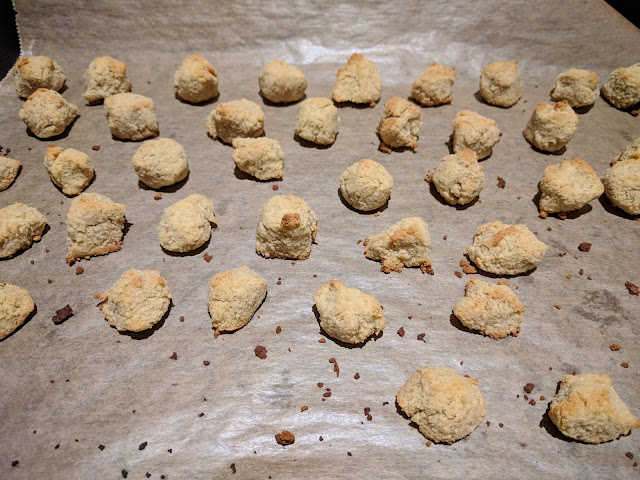Almond flour isn't just almond flour
Looking around on the internet for how much almond flour to use instead of regular flour, I kept finding big variations, from 1:1 replacement to 1:2. Since baking is fairly finicky with the amount of ingredients, this confused me. But when I grabbed an extra bag of almond flour at the local grocery store (yes, there are specialty flours at the grocery store here), I noticed a difference in consistency and decided to take a closer look.
Here's a close-up of the two flours using a macro lens. On the left is MeaVita Mandelmehl, on the right Borchers Premium Mandelmehl. In both cases, I've used a blunt instrument to gently distribute the flour to better see the difference.
The flour on the left, the MeaVita brand flour, is in much larger chunks than on the right. The MeaVita flour also feels more moist, though I don't know if that's a direct effect of the size or because more oil has been extracted from the Borchers flour.
It is, however, obvious that the two flours would not behave identically in baked goods. I haven't yet done systematic tests, but I would expect the Borchers fine flour to soak up more water and also to for a finer and less crumbly dough. I have no doubt that the Borchers is a better replacement, though I cannot yet speak to how the proportion should be.
Here's a close-up of the two flours using a macro lens. On the left is MeaVita Mandelmehl, on the right Borchers Premium Mandelmehl. In both cases, I've used a blunt instrument to gently distribute the flour to better see the difference.
The flour on the left, the MeaVita brand flour, is in much larger chunks than on the right. The MeaVita flour also feels more moist, though I don't know if that's a direct effect of the size or because more oil has been extracted from the Borchers flour.
It is, however, obvious that the two flours would not behave identically in baked goods. I haven't yet done systematic tests, but I would expect the Borchers fine flour to soak up more water and also to for a finer and less crumbly dough. I have no doubt that the Borchers is a better replacement, though I cannot yet speak to how the proportion should be.




This comment has been removed by the author.
ReplyDeleteHi Haardgrim,
ReplyDeleteI have trouble trusting almond flour since almond flour and flax flour go rancid so easily. The last time I tried to bake a flax and almond flour loaf from a recipe and followed the baking temperature the YouTube directions suggested, my loaf went rancid. I fear a temperature under 200 degrees Fahrenheit (93 degrees Celsius) is not something I would suggest when baking with almonds or flax in any form. Might I suggest at least 225F/107C?
Another good flour replacement would be peanut butter.
My Coeliac Grandma's Peanut Butter Cookies (recipe origin, unknown):
1 16 oz jar of peanut butter (about 1/2 kilogram)
2/3 cup of sugar (a whole cup if you like that better or your peanut butter is unsweetened/sugar-free)
2 eggs
1 teaspoon of vanilla
Just mix and bake like regular peanut butter cookies. The baker needs to let these cookies sit a moment or two, or bake them on top of parchment or waxed paper so the cookies can be moved without disturbing them. One needs to allow the sugar that keeps these cookies from coming apart time to harden so the cookies will keep their shape. Peanuts are an oily legume, anyway, so the use of peanut butter already provides the fats necessary to keep your cookies from sticking too badly.
My grandmother has said the only problem she has with baking these cookies is that they never seem to make it to her cookie jar. :]
As you can see by my example recipe, peanuts can also be used as a flour substitute (assuming allergies allow). Because peanuts are legumes, they are rich in protein and have phytoestrogens that are supposed to be good for preventing various female maladies and breast cancer.
Just my two coppers. Ignore me if you like. :)
Note: had to delete previous comment due to typos despite double-checking.
Thanks for your comments, I'm happy to get some feedback.
DeleteI have (as earlier posts describe) used flax flour in bread (baked at 200C) without any sign of rancidness, but almond flour is still something I'm finding my way around. I suppose it depends a lot on how much oil is left in the flour - but hardly anything get baked at less than 150C anyway, so that doesn't seem like a problem.
I tried two recipes for cookies that were based on almond flour and peanut butter, and while the results were delicious, they were more like fudge cakes than normal cookies.
Peanut butter as a flour substitute? Haven't thought of it that way. I'm still hoping to find something that's essentially a drop-in replacement in regular recipes - we don't have a problem with gluten, so I can get some of the usual flour structure from adding an appropriate amount of gluten powder, but peanut butter certainly behaves differently than flour.
The almond flour also gives a sweet taste, which works well in cookies, but might call for reducing the sugar (or sugar substitute, we use xylitol for now). So as a direct replacement it's again not perfect. I also suspect that various brands of almond flour have different amounts of oil in them, which at least changes how much water they absorb.